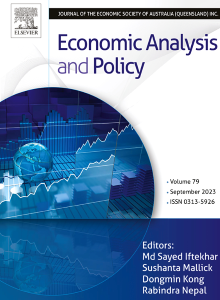Industry spillover effects of robot applications on labor productivity: Evidence from China
IF 8.7
2区 经济学
Q1 ECONOMICS
引用次数: 0
Abstract
This paper provides new insights into the industry spillover on labor productivity by discussing the spillover effects of robot application among industries in three spillover directions: horizontal, forward, and backward spillover. In addition, this paper measures the three spillovers with the weight matrices from the year 2012 input-output table by the Chinese National Bureau of Statistics. Using a spatial econometric model and 2000–2010 data on China's secondary industry, this paper tests three hypotheses relating to the direct effect and the spillover effects of robot applications. The main results show that the robot application of one industry can improve labor productivity significantly. Moreover, all three kinds of spillover have significant positive effects on the labor productivity of a focal industry. Among them, the forward spillover exerts the greatest impact on labor productivity. The heterogeneity effects exist due to the industry's factor intensity and technological structure etc. The findings of this study could provide several important implications for the development of a given industry and the industry chain of a country as well.
机器人应用对劳动生产率的行业溢出效应:来自中国的证据
本文从横向溢出、前向溢出和后向溢出三个溢出方向探讨了机器人应用在行业间的溢出效应,为劳动生产率的行业溢出提供了新的视角。此外,本文还利用中国国家统计局 2012 年投入产出表中的权重矩阵来衡量这三种溢出效应。本文利用空间计量经济模型和 2000-2010 年中国第二产业数据,检验了与机器人应用的直接效应和溢出效应相关的三个假设。主要结果表明,一个行业的机器人应用可以显著提高劳动生产率。此外,三种溢出效应都对重点产业的劳动生产率有明显的积极影响。其中,前向溢出对劳动生产率的影响最大。由于产业的要素密集度和技术结构等原因,存在异质性效应。本研究的结论可为特定产业和国家产业链的发展提供若干重要启示。
本文章由计算机程序翻译,如有差异,请以英文原文为准。
求助全文
约1分钟内获得全文
求助全文
来源期刊

Economic Analysis and Policy
ECONOMICS-
CiteScore
9.80
自引率
9.20%
发文量
231
审稿时长
93 days
期刊介绍:
Economic Analysis and Policy (established 1970) publishes articles from all branches of economics with a particular focus on research, theoretical and applied, which has strong policy relevance. The journal also publishes survey articles and empirical replications on key policy issues. Authors are expected to highlight the main insights in a non-technical introduction and in the conclusion.
 求助内容:
求助内容: 应助结果提醒方式:
应助结果提醒方式:


